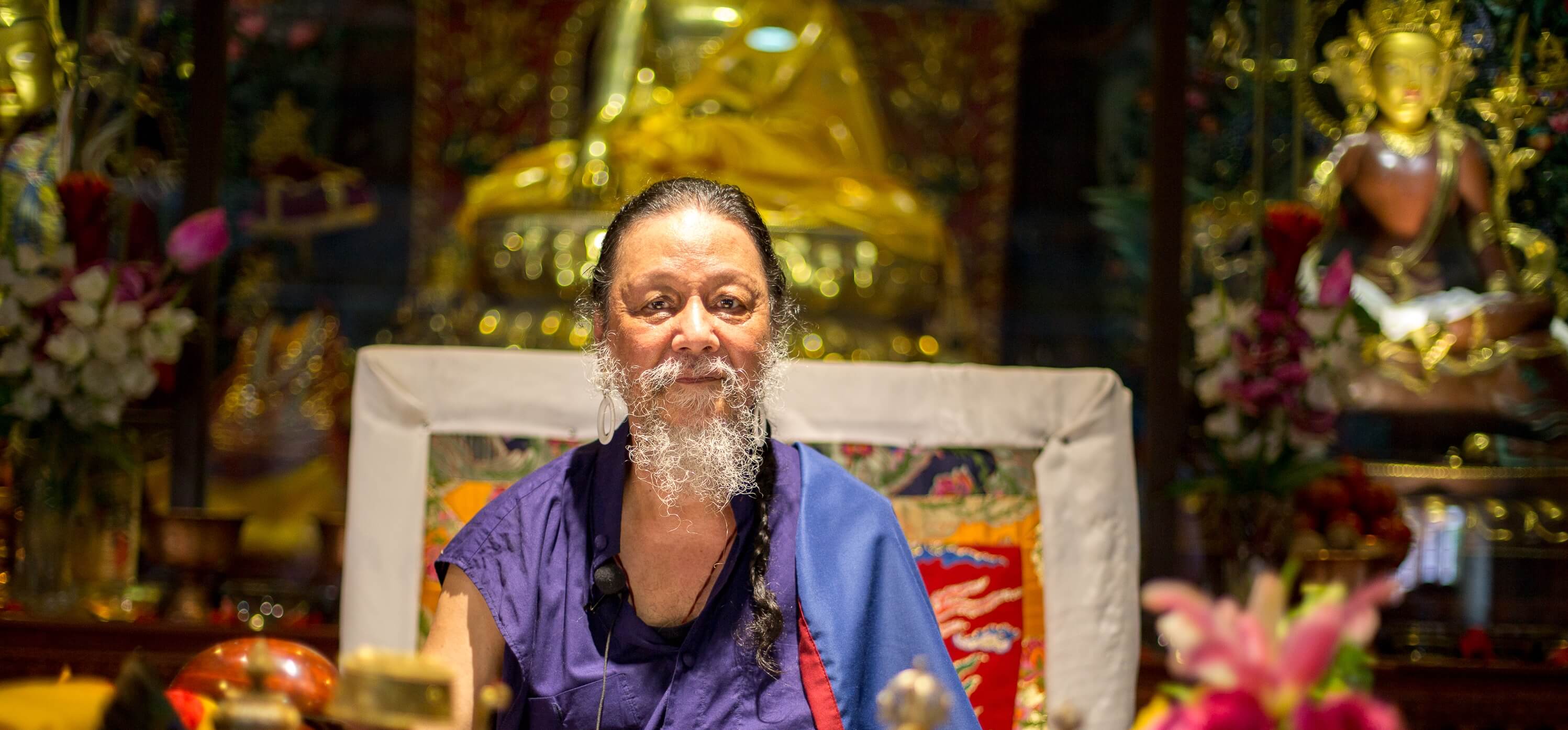The Vidyadhara Acharya Mahayogi Sridhar Rana Rinpoche
The Vidyadhara Acharya Mahayogi Sridhar Rana Rinpoche was born in Kathmandu, Nepal in 1949, the eldest child of Nara Narayan Shumsher Junga Bahadur Rana — a former Deputy Inspector General of Police and the grandson of the penultimate ruler of the Rana Dynasty, Maharaja Padma Shumsher Junga Bahadur Rana — and Shanti Rana, the daughter of Raja Jaya Prithvi Bahadur Singh, the humanist King of Bhajang.
The Vidyadhara began his spiritual pursuits early in life, and soon after graduating from St. Xavier’s High School — a Jesuit boarding school in Kathmandu — he began exploring Hindu Tantra under the guidance of his granduncle, Dhana Shumsher Junga Bahadur Rana. However, after failing to find spiritual fulfilment after nine years of intense practice, he began to practise under the famous Vedantic master, Khaptad Baba. However, here too he failed to find the answers to his questions, and this led him to seek them in the Buddhadharma.
In 1979 he began practising Zen under the guidance of Roshi Nanrei Kobori — the Abbot of Ryokoin, a sub-temple of the Daitokuji of Kyoto — and the Korean Master, Seung Sahn and his student, Zen Master Wu Bong (Jacob Perl). However, the difficulties in communicating with his teachers from Nepal led him to seek for qualified teachers within the Tibetan Buddhist community in Nepal, and in 1987 he met his first Vajrayana teacher, the Venerable Tulku Urgyen Rinpoche, considered by many to be among the greatest modern Dzogchen masters.
Tulku Urgyen Rinpoche further introduced him to various other masters, and from them he received numerous empowerments (Abhishekas/Wangs) and practice instructions. In April 1996, under the guidance of His Eminence (HE) the late Chobgay Trichen Rinpoche — the then head of the Tsarpa subdivision of the Sakya School — and His Holiness Kyabgon Gongma Trichen Rinpoche (The Sakya Trichen), he entered into retreat at his residence in Bishalnagar, Kathmandu.
After completing six and half years of retreat, Chobgay Trichen Rinpoche bestowed upon him the title of “Rinpoche”, and in 2006, at the end of his tenth year in retreat, he again bestowed upon him the tile of “Mahayogi” (Great Yogi). On 25 May, 2013, at the end of his seventeenth year in retreat, HE the Fourth Karma Thinley Rinpoche honoured him with the title of “Vidyadhara” (Wisdom Holder). Called Rigdzin in Tibetan, the title refers to one who constantly abides in the pure essence of the nature of mind and who has special knowledge of the use of different Vidyadharanis (Wisdom Mantras), their principles, origins, uses, etc. It was used in the past to address such accomplished Tantric masters as Mahasiddha Vimilamitra, Guru Padmasambhava, Mahasiddha Virupada, etc.
Now in his twentieth year of retreat, the Vidyadhara is committed to extending it to the rest of his life in the Tse Tsam style of the Tibetan tradition and as practised by the great yogi, Lama Shyabkar. This type of practice will allow for the retreat to be held in multiple places with short breaks.
Teachings and Disciples
Although he is under a strict practice schedule in retreat, the Vidyadhara has always found time to disseminate his teachings, primarily in the form of written discourses, which are translated from the original English into Nepali and read out by his chief disciple, Narayan Prasad Rijal, during monthly gatherings of the growing sangha. Three volumes of these teachings, entitled “Bodhipushpanjali” (The Flower Garland of Wisdom) have so far been compiled and published. In addition, the Vidyadhara has written prolifically, primarily in English, on various aspects of Buddhism, including defences of Mahayana and Vajrayana Buddhism, and his visions for Buddhism in the modern age.
While his Hindu background has facilitated his teachings and interactions in Nepal, his wide knowledge of western philosophy and psychology makes his style especially suited for western and western-oriented sangha members. In addition to traditional Vajrayana teachings, including those based on his termas, he also conducts healing and therapeutic workshops, and advocates integrating various psycho-therapeutic and psychological practices with Buddhist meditation techniques in order to expedite mind transformation and enable his disciples to advance rapidly along the path.
Besides the Vajrayana tradition of Tibet and Nepal, the Vidyadhara is also a scholar of Chan and Zen Buddhism; Jodo Shinshu; and the Abhidharma of the Mahayana, Vaibhashika and Theravada traditions. He also maintains a keen interest in both Zen and Theravada practices, and one of his aims is to make available all aspects of the Buddhadharma to those interested in studying and practising it. As such, he promotes a non-sectarian and universal Buddhist tradition, where all lineages and traditions of Buddhist practices are respected.
